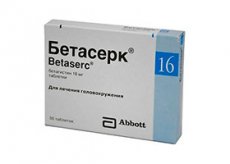Medical expert of the article
New publications
Preparations
Betaserk
Last reviewed: 03.07.2025

All iLive content is medically reviewed or fact checked to ensure as much factual accuracy as possible.
We have strict sourcing guidelines and only link to reputable media sites, academic research institutions and, whenever possible, medically peer reviewed studies. Note that the numbers in parentheses ([1], [2], etc.) are clickable links to these studies.
If you feel that any of our content is inaccurate, out-of-date, or otherwise questionable, please select it and press Ctrl + Enter.

Indications Betaserca
It is used for the following disorders:
- Meniere's disease;
- atherosclerosis in the area of the cerebral arteries, VBI and post-traumatic encephalopathy (part of combination treatment);
- syndromes characterized by tinnitus, progressive hearing loss and dizziness (including vestibular or labyrinthine disorders, hydrocele in the inner ear, as well as vestibular neuronitis, internal otitis and benign positional vertigo).
Release form
The drug is released in tablets with a volume of 8, 16 or 24 mg. Inside the blister plate there are 10, 15, 20, 25 or 30 tablets.
Pharmacodynamics
Betaserk is a synthetic analogue of the substance histamine. The mechanism of action of the element betahistine has not yet been fully studied. There are a number of theories that have previously been confirmed by clinical data:
- the active component of the drug is a partial stimulator of histamine H1 endings, as well as a blocker of the activity of histamine H3 endings of the vestibular centers of the nervous system;
- the drug improves histamine metabolism processes, as well as its release under the influence of the above factors;
- betahistine increases the intensity of blood flow in the inner ear by relaxing the vascular sphincters in this area, and in addition, it enhances the processes of cerebral microcirculation;
- the drug promotes the restoration of vestibular activity after neurectomy in this area;
- Depending on the dosage, it reduces the production of neural impulses within the vestibular nuclei.
The medicinal effect of betahistine has been registered in people with Meniere's disease, as well as with vestibular vertigo. The effect was manifested in a weakening of the intensity and a decrease in the number of vertigo attacks.
Pharmacokinetics
After oral administration, the active ingredient of the drug is absorbed inside the intestine and is almost completely converted, turning into a derivative of 2-pyridylacetic acid. Blood levels of betahistine are quite low.
Taking with food may slow down the absorption of the drug. Synthesis with blood protein is less than 5%. Cmax values of 2-pyridylacetic acid in the blood are noted after 60 minutes after taking. Half-life is about 3.5 hours.
The breakdown products of the drug are excreted in the urine, but the excretion of small amounts of betahistine occurs through the intestines or kidneys.
Dosing and administration
The medication is taken orally, with food. The dosage portion is selected individually, taking into account the patient's response to treatment.
The daily adult dose is usually 24-28 mg (it should be divided into 2-3 doses).
Sometimes the medicinal effect of Betaserc develops only after 2-3 weeks of therapy, and a stable effect is noted only after several months of regular use of the drug.
 [ 9 ]
[ 9 ]
Use Betaserca during pregnancy
It is prohibited to use Betaserc in the 1st trimester or during lactation. Taking it in the 2nd and 3rd trimesters is allowed only under the supervision of a doctor and if there are vital indications.
Contraindications
Main contraindications:
- the presence of hypersensitivity to medicinal elements;
- pheochromocytoma.
The drug should be used with caution (under the supervision of a doctor) by people with bronchial asthma or ulcers.
Side effects Betaserca
Taking the drug may lead to the occurrence of certain side effects:
- digestive disorders: vomiting, flatulence, dyspeptic symptoms, nausea and abdominal pain;
- disorders of the nervous system: headaches.
- signs of allergy: urticaria, anaphylaxis, rash, angioedema and itching.
Overdose
Symptoms of poisoning include mild nausea, drowsiness, and abdominal pain. More severe effects (such as seizures and cardiac reactions) have been reported with deliberate use in high doses.
To eliminate the manifestations, symptomatic treatment procedures are carried out.
Interactions with other drugs
When combining the drug with drugs that block MAO activity, suppression of Betaserc metabolism may be observed.
Betahistine is a histamine analogue, which is why it cannot be ruled out that it will affect the effectiveness of histamine H1-blocking substances.
 [ 10 ]
[ 10 ]
Storage conditions
Betaserk should be kept in a dry place, inaccessible to children, at standard temperatures.
Shelf life
Betaserk can be used within 5 years from the date of manufacture of the therapeutic agent.
Application for children
There is no information regarding the safety of Betaserc use by individuals under 18 years of age, so it is prohibited to prescribe it to this category of patients.
Analogues
Analogues of the drug are the drugs Vertran, Betahistine, Denoyz, Asniton with Alfaserc and Microser, and in addition Betacentrin, Bataserk, Betaver, Vestinorm, Vasoserk with Vestibo, as well as Tagista and Vesticap.
Reviews
Betaserk receives good reviews from patients and specialists. Often, people who have treated dizziness with the drug, accompanied by tinnitus and VSD, talk about the lack of medicinal effect. According to people commenting on forums, the drug rarely causes negative symptoms.
Attention!
To simplify the perception of information, this instruction for use of the drug "Betaserk" translated and presented in a special form on the basis of the official instructions for medical use of the drug. Before use read the annotation that came directly to medicines.
Description provided for informational purposes and is not a guide to self-healing. The need for this drug, the purpose of the treatment regimen, methods and dose of the drug is determined solely by the attending physician. Self-medication is dangerous for your health.

